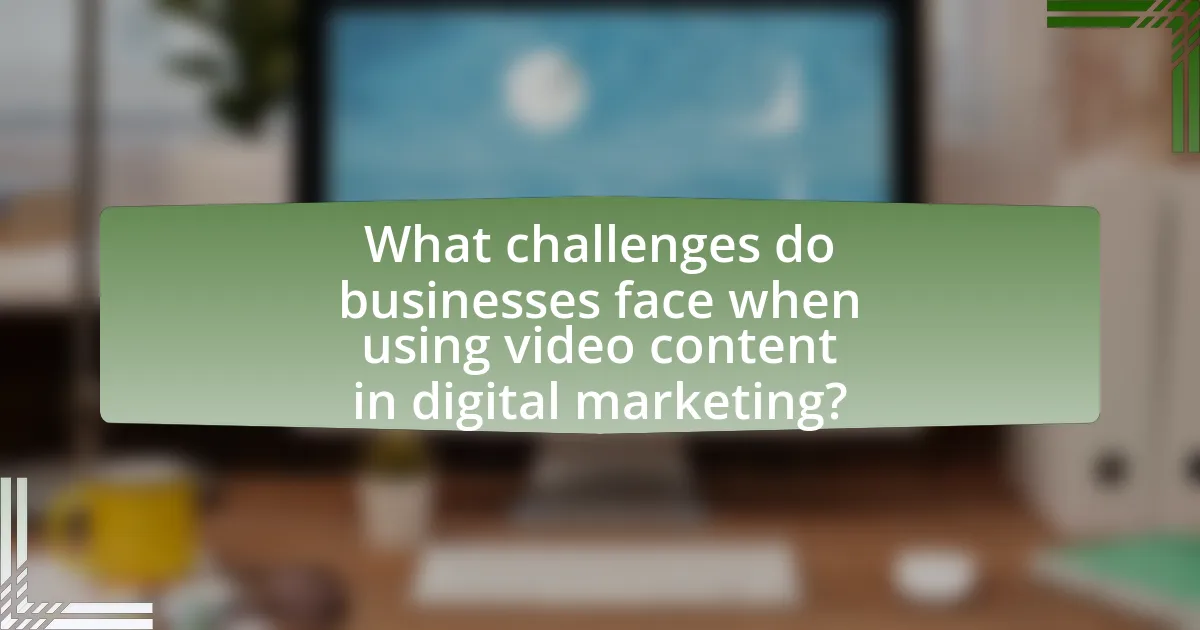Video content is a crucial element in digital marketing, offering significant benefits such as enhanced engagement and improved conversion rates. Research shows that incorporating video can increase conversions by up to 80% and boost social media views by 48%. The article explores how video content enhances audience engagement through emotional connections and storytelling, improves viewer retention rates, and influences consumer behavior. It also discusses the psychological factors that make video appealing, the role of video in SEO, and best practices for creating impactful video content while addressing common challenges businesses face in production and distribution.

What are the Benefits of Video Content in Digital Marketing?
Video content in digital marketing significantly enhances engagement and conversion rates. Research indicates that including video on landing pages can increase conversions by up to 80%. Additionally, video content is more likely to be shared on social media, with studies showing that social media posts containing video receive 48% more views. Furthermore, video improves information retention; viewers retain 95% of a message when they watch it in a video compared to only 10% when reading text. These statistics demonstrate that video content is a powerful tool for capturing audience attention and driving marketing success.
How does video content enhance audience engagement?
Video content enhances audience engagement by capturing attention more effectively than text or images. Research indicates that viewers retain 95% of a message when they watch it in a video compared to only 10% when reading it in text. This high retention rate is attributed to the combination of visual and auditory stimuli, which creates a more immersive experience. Additionally, videos can evoke emotions, leading to stronger connections with the audience. According to a study by Wyzowl, 84% of consumers say they’ve been convinced to buy a product or service after watching a brand’s video. This demonstrates that video content not only engages but also drives consumer behavior, making it a powerful tool in digital marketing.
What psychological factors make video content more appealing?
Video content is more appealing due to psychological factors such as emotional engagement, cognitive processing, and social validation. Emotional engagement occurs when videos evoke feelings, making viewers more likely to connect with the content; studies show that emotionally charged content can increase viewer retention by up to 95%. Cognitive processing is enhanced through visual storytelling, which aids in information retention and understanding; research indicates that people remember 80% of what they see and do compared to only 20% of what they read. Social validation is achieved through likes, shares, and comments, which create a sense of community and belonging; this phenomenon is supported by the social proof theory, where individuals are influenced by the actions of others. These factors collectively enhance the effectiveness of video content in digital marketing.
How does video content influence viewer retention rates?
Video content significantly enhances viewer retention rates by engaging audiences through visual and auditory stimuli. Research indicates that viewers retain 95% of a message when they watch it in a video compared to only 10% when reading text. This heightened retention is attributed to the combination of storytelling, emotional connection, and dynamic visuals that video provides, making it easier for viewers to remember information. Additionally, platforms like YouTube report that videos with engaging thumbnails and titles can increase click-through rates, further contributing to longer viewing times and improved retention.
Why is video content effective for brand storytelling?
Video content is effective for brand storytelling because it engages audiences emotionally and visually, enhancing retention and connection. Research indicates that viewers retain 95% of a message when consumed via video, compared to just 10% when reading text. This high retention rate is attributed to the combination of visual and auditory stimuli, which creates a more immersive experience. Additionally, video content can convey complex narratives quickly and effectively, making it easier for brands to communicate their values and messages. According to a report by Wyzowl, 84% of consumers say they’ve been convinced to buy a product or service after watching a brand’s video. This demonstrates the persuasive power of video in influencing consumer behavior and building brand loyalty.
What elements of video contribute to effective storytelling?
Visual elements, narrative structure, sound design, and pacing contribute to effective storytelling in video. Visual elements, such as cinematography and color grading, create an emotional tone and enhance viewer engagement. Narrative structure, including a clear beginning, middle, and end, helps convey the story coherently, making it easier for the audience to follow. Sound design, including music and sound effects, adds depth and can evoke specific emotions, reinforcing the narrative. Pacing, or the rhythm of the video, influences how information is presented and can build tension or excitement, keeping viewers invested. These elements work together to create a compelling and memorable storytelling experience in video content.
How can brands leverage video to convey their values?
Brands can leverage video to convey their values by creating authentic storytelling that resonates with their target audience. This approach allows brands to showcase their mission, vision, and ethical practices through engaging narratives, which can foster emotional connections with viewers. For instance, a study by Wyzowl found that 84% of consumers say they’ve been convinced to buy a product or service by watching a brand’s video, highlighting the effectiveness of video in communicating core values. By using testimonials, behind-the-scenes footage, and purpose-driven campaigns, brands can effectively illustrate their commitment to social responsibility and transparency, further enhancing their credibility and trustworthiness in the eyes of consumers.
What role does video content play in SEO and online visibility?
Video content significantly enhances SEO and online visibility by increasing user engagement and dwell time on websites. Search engines prioritize content that keeps users on a page longer, as this indicates relevance and quality. According to a study by Wistia, videos can increase the average time spent on a webpage by up to 88%, which directly correlates with improved search rankings. Additionally, video content is more likely to be shared across social media platforms, further amplifying reach and visibility. Research from HubSpot indicates that 54% of consumers want to see more video content from brands they support, highlighting the demand for video and its impact on attracting traffic.
How does video content impact search engine rankings?
Video content significantly enhances search engine rankings by increasing user engagement and dwell time on websites. Search engines prioritize content that keeps users on a page longer, as this indicates relevance and quality. According to a study by Wistia, videos can increase the average time spent on a page by up to 88%, which positively influences ranking algorithms. Additionally, video content can improve click-through rates in search results, as visually appealing thumbnails attract more clicks. This combination of increased engagement and higher click-through rates contributes to better search engine visibility and rankings.
What are the best practices for optimizing video content for SEO?
To optimize video content for SEO, focus on using relevant keywords in the title, description, and tags. This practice enhances discoverability, as search engines prioritize content that aligns with user queries. Additionally, creating engaging thumbnails and ensuring videos are mobile-friendly can significantly improve click-through rates. According to a study by HubSpot, videos that include a keyword in the title are 50% more likely to rank on the first page of search results. Furthermore, incorporating transcripts and captions not only aids accessibility but also provides search engines with more text to index, further boosting SEO performance.

How can businesses implement video content in their marketing strategies?
Businesses can implement video content in their marketing strategies by creating engaging and informative videos that align with their brand message and target audience. This can include product demonstrations, customer testimonials, behind-the-scenes footage, and educational content. According to a report by Wyzowl, 86% of businesses use video as a marketing tool, highlighting its effectiveness in increasing engagement and conversion rates. Additionally, platforms like YouTube, social media, and company websites serve as effective channels for distributing video content, allowing businesses to reach a wider audience. By analyzing viewer metrics and feedback, businesses can refine their video strategies to enhance viewer engagement and drive sales.
What types of video content are most effective for marketing?
The most effective types of video content for marketing include explainer videos, product demonstrations, customer testimonials, and live videos. Explainer videos succinctly convey complex ideas, making them ideal for introducing products or services; studies show that 94% of marketers believe video content increases user understanding of their product. Product demonstrations allow potential customers to see the product in action, which can lead to a 73% increase in purchase intent. Customer testimonials build trust and credibility, with 79% of consumers stating they trust online reviews as much as personal recommendations. Live videos create a sense of urgency and engagement, as they can generate up to six times more interactions than traditional videos.
How do explainer videos differ from promotional videos?
Explainer videos differ from promotional videos primarily in their purpose and content focus. Explainer videos aim to clarify a concept, product, or service by providing detailed information and demonstrating how it works, often using animations or visuals to enhance understanding. In contrast, promotional videos focus on marketing a product or service, emphasizing its benefits and features to persuade viewers to make a purchase or take action. For instance, a study by Wyzowl found that 94% of marketers believe explainer videos effectively increase user understanding, while promotional videos are designed to drive sales and brand awareness.
What are the advantages of live streaming for businesses?
Live streaming offers businesses several advantages, including increased engagement, real-time interaction, and broader reach. By utilizing live streaming, companies can connect with their audience instantly, fostering a sense of community and immediacy that pre-recorded content cannot achieve. According to a study by Livestream and New York Magazine, 80% of consumers prefer to watch live videos from brands rather than reading their blogs, highlighting the effectiveness of live streaming in capturing audience attention. Additionally, live streaming can enhance brand visibility, as platforms like Facebook and Instagram prioritize live content in their algorithms, leading to higher organic reach.
How can businesses measure the success of their video content?
Businesses can measure the success of their video content through key performance indicators (KPIs) such as view count, engagement rate, conversion rate, and audience retention. View count indicates how many times the video has been watched, providing a basic measure of reach. Engagement rate, calculated by assessing likes, shares, comments, and click-through rates, reflects how well the content resonates with viewers. Conversion rate tracks the percentage of viewers who take a desired action, such as signing up for a newsletter or making a purchase, directly linking video performance to business goals. Audience retention measures how long viewers stay engaged with the video, revealing its effectiveness in maintaining interest. According to a report by Wistia, videos that retain 50% of viewers for at least 30 seconds are considered successful in engaging their audience.
What metrics should be tracked to evaluate video performance?
To evaluate video performance, key metrics to track include view count, watch time, engagement rate, click-through rate (CTR), and conversion rate. View count indicates the number of times the video has been watched, providing a basic measure of reach. Watch time measures the total minutes viewers spend watching the video, which is crucial for understanding viewer retention and interest. Engagement rate, calculated through likes, shares, and comments, reflects how well the content resonates with the audience. Click-through rate assesses how effectively the video drives viewers to take action, such as visiting a website or signing up for a newsletter. Lastly, conversion rate measures the percentage of viewers who complete a desired action, such as making a purchase, indicating the video’s effectiveness in achieving marketing goals. These metrics collectively provide a comprehensive view of a video’s performance in a digital marketing context.
How can audience feedback improve future video content?
Audience feedback can significantly enhance future video content by providing insights into viewer preferences and engagement levels. Analyzing comments, likes, and shares allows content creators to identify what resonates with their audience, leading to more targeted and effective video production. For instance, a study by Wyzowl found that 76% of marketers believe that video content has helped them increase traffic, indicating that understanding audience feedback can directly influence content strategy and improve viewer retention. By incorporating this feedback, creators can refine their messaging, adjust their visual style, and focus on topics that generate interest, ultimately leading to higher engagement and conversion rates.

What challenges do businesses face when using video content in digital marketing?
Businesses face several challenges when using video content in digital marketing, including high production costs, the need for technical expertise, and difficulties in measuring effectiveness. High production costs can deter companies from creating quality videos, as professional equipment and editing software can be expensive. Additionally, businesses often lack the technical skills required to produce engaging video content, which can lead to subpar results. Furthermore, measuring the effectiveness of video campaigns can be complex; traditional metrics like views and likes do not always correlate with actual engagement or conversion rates, making it challenging for businesses to assess their return on investment accurately.
What are common pitfalls in video content creation?
Common pitfalls in video content creation include inadequate planning, poor audio and visual quality, and neglecting audience engagement. Inadequate planning often leads to disorganized content that fails to convey a clear message, resulting in viewer disengagement. Poor audio and visual quality can detract from the viewer’s experience; studies show that 80% of viewers will abandon a video if the audio is poor. Neglecting audience engagement, such as failing to include calls to action or not responding to viewer comments, can diminish the effectiveness of the video in achieving marketing goals. These pitfalls can significantly undermine the potential benefits of video content in digital marketing.
How can businesses avoid overspending on video production?
Businesses can avoid overspending on video production by establishing a clear budget and sticking to it throughout the project. By defining specific goals and requirements for the video, businesses can prioritize essential elements and eliminate unnecessary costs. For instance, according to a study by Wyzowl, 83% of businesses believe video is essential for marketing, but those that plan their production process effectively can reduce costs by up to 30%. Additionally, leveraging in-house resources, such as existing equipment and personnel, can further minimize expenses while maintaining quality.
What technical issues can arise during video production and how can they be resolved?
Technical issues that can arise during video production include poor audio quality, lighting problems, and equipment malfunctions. Poor audio quality can be resolved by using high-quality microphones and monitoring audio levels during recording. Lighting problems can be addressed by utilizing proper lighting equipment and techniques, such as three-point lighting, to ensure adequate illumination. Equipment malfunctions can be mitigated through regular maintenance and having backup equipment available, which is essential for minimizing downtime during production. These solutions are supported by industry best practices that emphasize the importance of preparation and quality control in video production.
How can businesses overcome distribution challenges for video content?
Businesses can overcome distribution challenges for video content by leveraging multiple platforms and optimizing content for each channel. Utilizing social media platforms, video hosting sites, and email marketing allows businesses to reach diverse audiences effectively. For instance, according to a report by Wyzowl, 86% of businesses use video as a marketing tool, highlighting its importance in engaging customers across various platforms. Additionally, optimizing video content for SEO, including relevant keywords and descriptions, enhances discoverability, further addressing distribution challenges.
What platforms are best for sharing video content effectively?
YouTube, Facebook, Instagram, and TikTok are the best platforms for sharing video content effectively. YouTube is the largest video-sharing platform, with over 2 billion monthly users, making it ideal for reaching a wide audience. Facebook supports video content through its news feed and has over 2.9 billion monthly active users, enhancing engagement through shares and comments. Instagram, with its focus on visual content, allows for short videos and Stories, appealing to younger demographics, while TikTok specializes in short-form videos, boasting over 1 billion monthly active users, which encourages viral sharing and creativity. These platforms collectively offer diverse formats and extensive reach, making them optimal for effective video content distribution in digital marketing.
How can businesses ensure their video content reaches the right audience?
Businesses can ensure their video content reaches the right audience by utilizing targeted marketing strategies such as audience segmentation, leveraging analytics, and optimizing distribution channels. Audience segmentation allows businesses to categorize potential viewers based on demographics, interests, and behaviors, ensuring that video content is tailored to specific groups. Analytics tools, such as Google Analytics and social media insights, provide data on viewer engagement and preferences, enabling businesses to refine their content and targeting strategies. Additionally, optimizing distribution channels, including social media platforms and email marketing, ensures that video content is shared in spaces where the target audience is most active, increasing the likelihood of engagement. According to a report by HubSpot, 54% of consumers want to see more video content from brands they support, highlighting the importance of reaching the right audience effectively.
What are the best practices for creating impactful video content?
To create impactful video content, focus on storytelling, audience engagement, and high production quality. Storytelling captivates viewers by presenting relatable narratives, which can increase viewer retention; studies show that stories can boost engagement by up to 300%. Engaging the audience through interactive elements, such as polls or questions, enhances viewer participation and fosters a sense of community, leading to higher conversion rates. High production quality, including clear visuals and sound, establishes credibility and professionalism, which is crucial as 80% of consumers are more likely to engage with a brand after watching a quality video.
How can storytelling techniques enhance video effectiveness?
Storytelling techniques enhance video effectiveness by creating emotional connections with the audience, which increases engagement and retention. When videos incorporate narratives, they can evoke feelings and foster relatability, making the content more memorable. Research indicates that storytelling can improve information retention by up to 65% compared to traditional presentation methods. This is because stories activate multiple areas of the brain, allowing viewers to visualize and empathize with the characters and situations presented. Consequently, effective storytelling in videos not only captures attention but also drives action, as viewers are more likely to respond to content that resonates with them on a personal level.
What tips can improve video production quality on a budget?
To improve video production quality on a budget, focus on using natural lighting, which enhances visual clarity without additional costs. Utilizing available light sources, such as windows, can significantly improve the overall look of the video. Additionally, investing in a decent microphone is crucial, as audio quality often matters more than video quality; clear sound can elevate the viewer’s experience. Furthermore, employing simple editing software can help refine the final product, allowing for cuts, transitions, and color corrections that enhance professionalism. Research indicates that videos with good audio quality retain viewer attention 50% longer than those with poor sound. By implementing these strategies, creators can produce high-quality videos without overspending.




